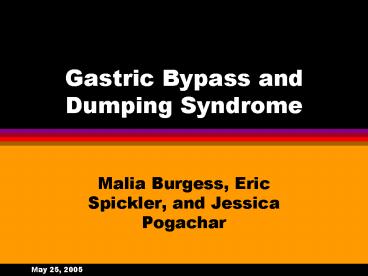Gastric Bypass and Dumping Syndrome - PowerPoint PPT Presentation
1 / 11
Title:
Gastric Bypass and Dumping Syndrome
Description:
... is made smaller by a double row of staples near the top of the stomach, making a ... http://www.emedicine.com/med/topic589.htm. Web MD ... – PowerPoint PPT presentation
Number of Views:1224
Avg rating:3.0/5.0
Title: Gastric Bypass and Dumping Syndrome
1
Gastric Bypass and Dumping Syndrome
- Malia Burgess, Eric Spickler, and Jessica Pogachar
2
Gastric Bypass
- the stomach is made smaller by a double row of
staples near the top of the stomach, making a
small pouch. - The small pouch is then directly connected to the
middle section of the jejunum. - The two parts of the small intestine are then
connected forming a Y shape to allow for the
unused portion of the stomach to drain.
3
Contribution to Weight Loss
- Restriction of stomach size allows for only a
small amount of food at any given time - Opening of jejunum that attaches to the stomach
is smaller allowing for a slower flow of food out
of the stomach giving a feeling of being full for
a longer period of time. - Bypassing the upper portion of the small
intestine leads to a smaller amount of ingestion
of the food into the body.
4
Dumping Syndrome
- Dumping Syndrome is caused by the intake of
sugars and fats and results in palpitations of
the heart, sweating, queasiness, nausea, and
diarrhea. - The patient also feels weak and has to lie down
for 30-60 minutes due to the symptoms. - Why and how are the digestive and cardiovascular
symptoms of Dumping Syndrome are related?
5
Relevance to Lecture
- Functions of the stomach and small intestine in
digestion - Blood plasma volume
- Compensation of heart rate due to decreased
volume of blood
6
Hyperosmolar Load Theory
- Osmotically active substances pass through the
stomach rapidly causing the flow of water into
intestinal lumen. - This is a result of the shortening of the stomach
resulting in a smaller reservoir to store and
digest food. - Digestion of food also decreases due to decreased
secretion of gastric juices as well as the
absence of duodenal feedback to signal release of
contents when ready. - Diarrhea may result
7
Cont.
- The increase of water into the intestinal lumen
causes a decrease in blood plasma volume
resulting in low blood pressure. - The SNS stimulates
- increased heart rate to compensate for the
decrease in blood pressure, resulting in an
increase in blood flood and increased blood
pressure to maintain homeostasis. - vasoconstriction
- sweating
- Patient may complain of weakness
- Queasiness and nausea are caused by the
overstretching of the stomach by a large quantity
of food and the excess water within the
intestinal tract.
8
Dietary Changes
- Intake of 6 small meals
- Liquid intake 30 minutes after a meal, not with
the meal - Milk products should be avoided
- Intake of only simple sugars
- Increase of protein and fat intake to make up for
loss of carbohydrates.
9
Analogy
- Gastric bypass is analogous to a short cut
through the city instead of the long drive around
through the county. Its shorter and wastes less
time but you miss out on the nice scenery
(nutrients). - Dumping is analogous to trying to get all your
tasks done too quickly and catching a cold from
not taking care of yourself.
10
References
- E-Medicine
- http//www.emedicine.com/med/topic589.htm
- Web MD
- http//my.webmd.com/hw/weight_control/hw252819.asp
11
Questions?































